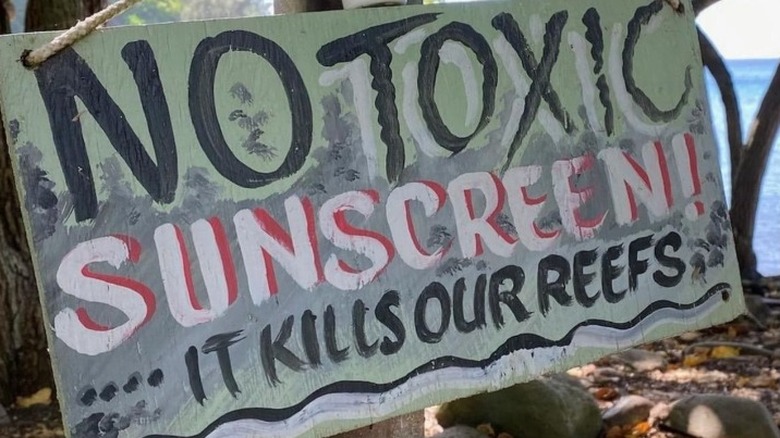What To Know About The Risks Of Oxybenzone In Your SPF
Whether it's a scorching hot day or the clouds are out to play, sunscreen is essential. It's dangerous not to wear SPF daily. Those harmful UV rays are more potent than you may think and can penetrate through the clouds and onto your skin, increasing the risk of skin damage and cancer (per the Centers for Disease Control and Prevention). In fact, according to the CDC, UV rays can bounce off water, snow, and even sand.
When you apply certain sunscreens, you probably aren't aware of the many chemicals that are meeting your body. And although sunscreen is regulated by the U.S. Food & Drug Administration to ensure that any SPF meets safety and efficacy standards (per the FDA), it's still important to know about the risks associated with the chemicals.
One of the most popular chemicals is oxybenzone. "Oxybenzone is a chemical sunscreen ingredient that's an organic UV filter," which dermatologist Corey L. Hartman says, "is one of the more common ingredients included in chemical sunscreens," (via Byrdie). These sunscreens effectively shield your skin, "but it has to take place through a chemical reaction, and that's why they're called chemical sunscreens," Hartman explains. And while oxybenzone can be instrumental in protecting your skin from the sun's rays, it has risks you'll want to know about.
Oxybenzone can trigger allergies and adverse reactions
Although classified as safe to use, sunscreen that includes oxybenzone can lead to allergic reactions in some individuals. Healthline notes that the reactions can range from slight irritation and itchy bumps to bleeding, scaling, and hives. Those with sensitive skin are more at risk of developing side effects and uncomfortable symptoms.
Rare severe reactions like anaphylaxis can occur for those with pre-existing skin conditions, as described in The Journal of Allergy and Clinical Immunology. They shared a case of a 22-year-old woman with a few skin conditions who went into anaphylactic shock as a result of the chemical. While considered rare and unlikely for most, those with pre-existing skin conditions may be susceptible to severe adverse reactions.
According to Len Lichtenfeld, MD, deputy chief medical officer of The American Cancer Society, "The jury is still out" on the serious safety risk of oxybenzone. "I'm concerned about the human impact to limiting the use of sunscreen. I personally accept the FDA's advice that available sunscreens are safe. But I encourage people to read the reports for themselves and make an individual decision on the type of sunscreen and what ingredients they should use."
Oxybenzone seeps into the bloodstream
If we told you that a chemical applied to the skin seeps into your bloodstream, you might not be initially alarmed. After all, many things will probably enter the blood once applied to the skin or consumed. But what if we told you more research needs to be done to understand how safe it is?
CNN reports that a few studies were conducted in 2020 by the Center for Drug Evaluation and Research, which found that seven chemicals enter the bloodstream after a single sunscreen application — but what does that mean? "What is most alarming about these findings is that chemicals are absorbing into the body in significant amounts, and the ingredients have not been fully tested for safety," David Andrews, a senior scientist for a sunscreen safety organization Environmental Working Group, told CNN. More testing needs to be done to determine if there are any risks at all to this finding. So, it's essential to proceed with caution with the limited amount of data we have.
With this information in mind, the FDA still recommends people use it. According to the U.S. Food & Drug Administration, the potential dangers of these ingredients, as well as the effect on users, is unknown, so even though oxybenzone (among other chemicals) does enter the bloodstream, that doesn't necessarily mean there will be harm done. The FDA urges all Americans to continue to use sunscreen while they continue to gather more data and information.
Some countries have banned oxybenzone
The Environmental Working Group claims oxybenzone is "the most worrisome" of the SPF chemicals that enter the bloodstream. In fact, they note that Europe has limited the amount of oxybenzone in its sunscreen products. In America, sunscreen is permitted to have up to 6% of the chemical, while Europe capped it at 2.2%. Not only that, but a handful of countries have banned oxybenzone because of its potential adverse effects on marine life.
Therefore, it's recommended, even by dermatologists, to reach for mineral-based sunscreen instead. "While it is unclear if the levels at which chemical sunscreen ingredients have been detected in the bloodstream pose any risk to human health, mineral-based sunscreens are generally recognized as safe and effective," Yale Medicine dermatologist surgeon Kathleen Suozzi told Yale Medicine. "Using them instead of chemical-based sunscreens avoids concerns about potential, unproven systemic effects."
According to Suozzi, mineral-based sunscreen is a gentler option for sensitive skin and is not as likely to result in skin reactions and allergies. You'll want to read the label on the package and look for zinc oxide or titanium dioxide as an active ingredient, which are natural mineral ingredients found in sunscreen (per ColoreScience). There are vast differences between mineral and chemical sunscreen, so you'll want to pick the one that's right for you. Of course, if you want to continue using your chemical sunscreen, we — and the FDA — support you.



